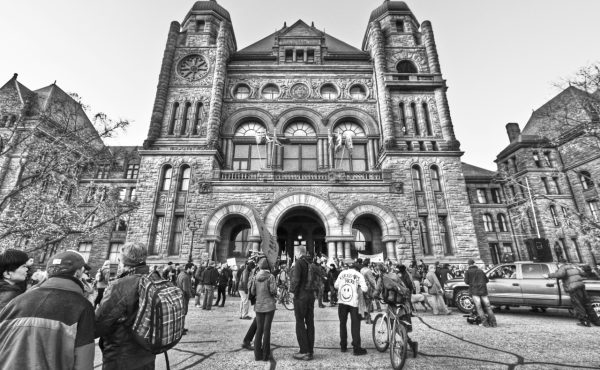
Councillor Joe Mihevc has served his midtown Ward 21 for 17 years. The son of blue collar Slovenian immigrants, Councillor Mihevc began his political career in 1991 by beating an incumbent councillor in the former City of York, and eventually became deputy mayor of the former Metro’s poorest municipality. A former professor of ethics at the University of Toronto, Councillor Mihevc is respected by his council colleagues on all sides of the political spectrum. Mihevc’s ability to build bridges with the center-right of the Lastman councils allowed the socially progressive councillor to gain the chairmanship of the Board of Health, where he championed key public health legislation like the smoking and pesticide bans. In the Miller Administration, Councillor Mihevc has held key roles, including vice-chair of the Budget Committee, vice-chair of the Toronto Transit Commission and chair of the Community Development & Recreation Committe.
ability to build bridges with the center-right of the Lastman councils allowed the socially progressive councillor to gain the chairmanship of the Board of Health, where he championed key public health legislation like the smoking and pesticide bans. In the Miller Administration, Councillor Mihevc has held key roles, including vice-chair of the Budget Committee, vice-chair of the Toronto Transit Commission and chair of the Community Development & Recreation Committe.
Yesterday, Councillor Mihevc unveiled the Everyone Gets to Play [PDF] strategy that is aimed at increasing the quality and quantity of programs offered by Parks & Recreation, as well as enhancing accessibility to low income Torontonians. However, while more free drop-in programs will be offered and students in select grades will be provided with free courses, most Torontonians will see the cost of recreation programs increase 66% by 2015. (See Globe and Mail story for more detail.)
To shed more light on the Everyone Gets to Play plan, Councillor Mihevc made time to answer a few questions between dinner with his family and a community meeting.
Adam Chaleff-Freudenthaler: What is your long-term vision for recreation in the City of Toronto?
Joe Mihevc: We have much more vigorous programs, high quality programs. They are accessible to everybody regardless of income, geographic location, age, colour, creed, whatever. We want to give everyone a chance to play.
ACF: Why should Torontonians pay more for recreation programs?
JM: At the present moment we do not have enough money available from the tax base. In an ideal world, frankly, I’d prefer that more of it get pushed to the tax base because this is part of the larger public good that needs to be recognized here. For example, all of us are fit and there’s a higher quality of life for the whole community. But we have very tough choices to make because of the last 10 years with downloading and the Megacity so it’s really hard to go to the treasurer or the Budget Committee — even though I sit on the Budget Committee — and say we need to get this money from the property tax base. There’s only so much to go around and we have limits on how much we can raise property taxes. So in reality, it’s raise user fees or don’t do anything and I don’t think “don’t do anything†is an option.
ACF: Part of the “case for change” in recreation fees is that recreation has had a large negative variance in the range of $3-7 million at the end of almost every year since amalgamation. However, Police Chief Bill Blair was recently on Global Television’s Focus Ontario boasting of annual positive variances in the same range. Why can’t these two budgets be managed in a way that gets both closer to “even” at the end of the year?
JM: The police budget is 7-800 million a year so for (Chief Blair) to squeeze out a few million dollars at the end of the year isn’t hard. But just transferring one to the other isn’t how it works. This year (Chief Blair) was able to offer (a positive variance) and last year he was able to but some years he can’t and there will even be a negative. And this strategy is about getting $35 million per year more into recreation.
ACF: By 2010, what improvements can residents expect to see in their local community center?
JM: You’ll see better quality programs, a lot more programs, a lot more drop in/free programs and you’ll see a lot more kids there participating in the swimming survival course and if there’s a rink you’ll see (kids) at the rink learning to skate. And you might see more youth there participating in the youth leadership program that is being offered for free to grade 8s and grade 9s.
ACF: The Everybody Gets to Play strategy has been criticized by your often-ally Councillor Gord Perks because of its shift to greater levels of income testing and away from universal access to recreation. How do you respond?
JM: What I think we need to understand is that to offer universality, which is what I think Gord (Perks) wants to do, we need to do it on a program level so it applies across the city. So downtown Toronto isn’t treated any differently than Scarborough or North York or Etobicoke. Right now we’re doing swim survival, learn to skate and youth leadership (ed. note: these are the courses offered free to students). If you want beginner swimming, intermediate swimming or senior swim across the board, if you have the money to do it in the budget process, then you do it across the whole city so it isn’t in just a few places. That’s the way you build the universality.
Also, though the priority centers (community centers that offer all programs for free) won’t continue (as priority centers), what we find in the (staff) report is that a lot of the (priority center) spaces are being filled by people outside the area who can well afford to pay. What’s happening then is that those people who are in the poor neighbourhoods are being squeezed out of the programs because people in neighbourhoods like, let’s say Humewood, are able to navigate the system better and get their kids in the programs faster than, say, a new immigrant mom in the Parkdale area. So we’ve found that priority centers don’t put their programs in the FunGuides and instead offer them all as drop-ins, since they’re free, and do outreach to the local kids so they get a chance to participate.
So what’s happening now is not abuse but people were using them in a way that we weren’t reaching our goals, which were to offer free programs to those who need it.
The current system is broke.
Also, the priority centers are not in the priority neighbourhoods [PDF]. They tend to be downtown because years ago (before amalgamation) when these priorities were established they were mostly in the old City of Toronto. Now the neediest people are in the suburbs. So we don’t have more money to open more priority centers — which is what I would like as much as anybody else — so the geographic-based system is really just not working. Frankly, if you’re living in Malvern, where there are no priority centers, why should you have to be income tested and not treated the same as someone in Parkdale? So what we’re trying to do is have an income test for the whole city that is fair from one end to the other.
ACF: How will the City determine what the maximum income eligible for a recreation subsidy is?
JM: A lot of residents will have already been income tested through Ontario Works or childcare subsidies. Otherwise they can bring in two pay stubs that show they meet the Low Income Cut Off [PDF]. I’m not sure what that is right now but it’s different whether you’re single, married, have kids, whatever.
But 11-15% of Torontonians have been income tested and will qualify. We’ve never received complaints about income testing. Right now we have 15,000 people registered for the Welcome Policy and we expect that will grow to 27,000. Even with that increase, we think that will only capture 20% of the people we think could use (the Welcome Policy).
ACF: The new fee structure has been criticized for putting the greatest burden on middle income families. How will the City ensure that this key demographic in a liveable city isn’t squeezed out of recreation in Toronto?
JM: At the end of the day, our programs right now are about $30 to $40 so they’ll go up to $50 to $60. If you compare that to the private sector and if you compare that to what’s happening in the GTA, we’re still the lowest, by far, in the Greater Toronto Area.
People will still be getting bang for their buck since they’ll only be paying for 50% of the cost of the program, which means the other 50% is communal responsibility since there’s community and personal benefits.
ACF: Local hockey leagues — elite and house leagues — have said that increased fees jeopradize their existance and/or ability to remain affordable for the average family. Given the cultural significance of hockey in Toronto, how have you balanced the need for affordable ice time (outside of pleasure skating)?
JM: The Toronto Star got it wrong on that. This has nothing to do with increased rental rates for ice rinks. We do a permit fee review every year or two and that’s part of the budget process. That review is done for everything like parking lots, planning department fees, building department fees and others in addition to ice rinks.
Let me just restate that this is not about the money. This is about better quality programs, more programs and programs for lower income people.
ACF: Councillor Karen Stintz has criticised the Everybody gets to Play strategy for the free lessons it will offer to TDSB and TCDSB students in swimming (grade 4), skating (grade 5) and leadership (grades 8 and 9). Why is it important for the City to deliver those particular programs? Why will they be delivered to every student and not just those in low income neighbourhoods?
JM: (Councillor Stintz) wants everything to be a user-pay approach. We think a right of residency for all Torontonians is that they learn how to swim to survive so they don’t drown, and this will basically entice kids into recreation so, if you want to use a business term, it works as a “loss leeder.â€
We also think that every Torontonian should learn how to skate. People who are immigrants are often too scared to learn how to skate or take their kids to the rink. I didn’t know how to skate until I was in grade 7 because my parents, it wasn’t even in their thought (to take me to a skating rink).
With the swimming, this is also a way to support school pools so this will add some money to those so they don’t have to close. Someone asked me yesterday, “this is going to help the schools a lot, isn’t it?†I told them yes, it will add $1.1 million to the schools’ coffers.
ACF: Generally speaking, there has been a trend toward increasing user fees for particular services — TTC, garbage collection, recreation — by amounts far greater than inflation while keeping property tax increases much more in line with inflation. Notwithstanding that you have been a leading advocate for increased funding from other orders of government for public transit and municipalities in general, you have supported the three examples of user fee increases. Why do you think that a “user pays” approach to municipal government is better for gathering new revenue than increased property taxes?
JM: I support increasing property taxes. But I’m operating in the mayor’s commitment to keeping property taxes to 3% or 4%. I’m honouring the commitment that he has made. Given that and that we want these services for our residents and that the province has come forward only modestly, we have to look at some of these things. We don’t have a choice. We do it with a user fee or we don’t do it at all. I think it’s a worse world if we don’t do it. It’s the same thing with the TTC; the only reason I’m increasing the price of tickets is so we can keep the system together.
So here’s the hierarchy: more things could be coming off income tax system because that’s the most progressive form of taxation. The next form of taxation that is fairer (than a user fee) is the property tax system but that is a blunt instrument. Below that is user fees and below that is service cuts. Given the choices that we’ve got, a user fee is preferable to a service cut.
For those who would like to have their voice heard on this issue, details on consultations are available here.
Photograph by boukesalverda.



